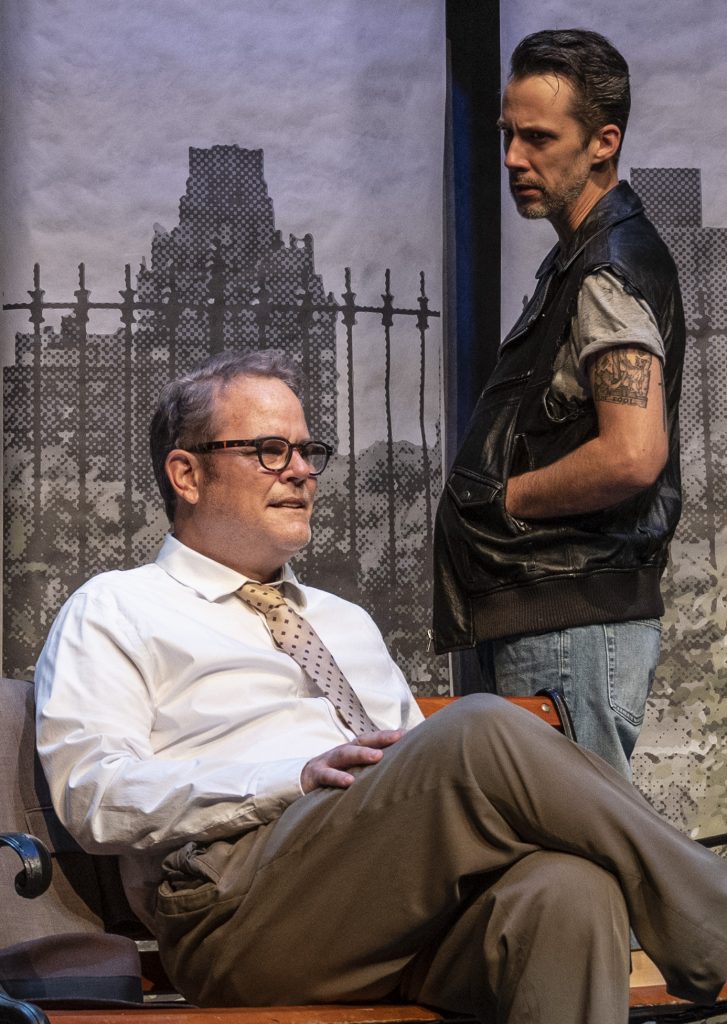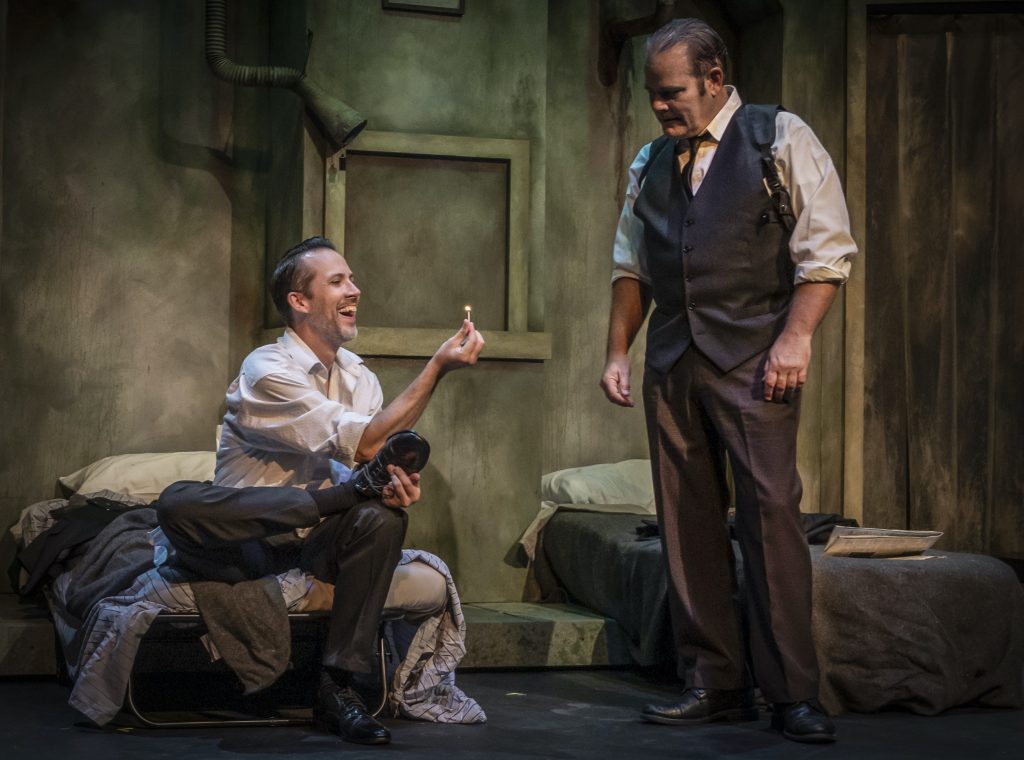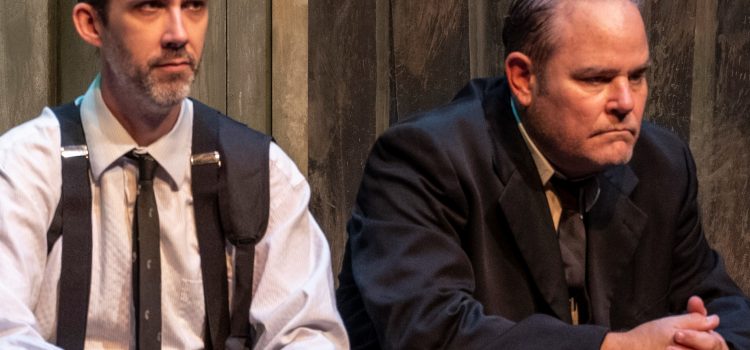By Lynn Venhaus
By the numbers: 2 one-act plays, 2 renowned 20th century playwrights, 2 professional actors, a 97-seat black box — with COVID-19 protocols in place — and one professional theater company restarting its 14th season.
The more things change, the more they remain the same. One thing is for certain – the awards magnet St. Louis Actors’ Studio has re-opened with the edgy, gritty dramadies that it specializes in, re-emerging with an acting showcase on stage at The Gaslight Theatre.
After being dark during the public health crisis of 2020 and 2021, pre-vaccine, these early 1959 works by two iconic individual voices, “The Zoo Story” by Edward Albee and “The Dumb Waiter” by Harold Pinter, are vivid and evocative some 60 years later
It’s all the ingredients necessary to create a mesmerizing live theatrical experience.
Newcomer Joel Moses announces his arrival in St. Louis with two masterful portraits, holding his own with veteran William Roth, who is also the company’s artistic director. The original 14th season was called “Two to Tango,” and their pas de deux is a master class in duet acting.

Starting with Edward Albee’s first play, “The Zoo Story,” it’s immediately apparent that we are in for something special. The one-act, written in 1958, is where Albee, a rebellious youth with wealthy adoptive parents, crafted a work by using themes we’d become more familiar with as he explored dark societal issues.
He won three Pulitzer Prizes for Drama, and his 1962 masterpiece “Who’s Afraid of Virginia Woolf?” won the Tony Award. “The Zoo Story” is where it all began, thus creating a sea change in American postwar theater, and won the 1960 Obie Award.
As powerful today as when it first appeared in regional theater (rejected by New York status quo), “The Zoo Story” is about isolation, loneliness, class and economic disparities, dehumanization of marginalized people, and the pitfalls of living in a material world.
All of that is brought to life in finely tuned performances by Roth and Moses as Peter and Jerry. They meet on a park bench in Central Park one sunny Sunday afternoon.
Peter, as is his custom, is reading a book in solitude. A married publisher of some means has two daughters, two cats and two parakeets.
He intrigues Jerry, who engages Peter in conversation. As is immediately obvious, Jerry has issues – lonely, disconnected, desperate, he craves companionship. He has no filter and no boundaries, a lost soul.
It’s apparent who is the have-not in this twosome. Jerry’s façade cracks early, and his behavior becomes increasingly alarming. As unsettled as Peter is, his manners allow him a sense of decorum, until the situation escalates.
What was disturbing back in 1960, when the play was first produced off-Broadway with William Daniels and George Maharis as Peter and Jerry, remains distressing today – but for different reasons. Back then, such unstable behavior hadn’t been normalized by society – it was shocking. Sadly, we can see what’s coming by looking through the rear-view mirror of 2021. This is what happens, Albee says, when people are discarded as worthless by society.
Albee’s trademark biting dialogue is handled with seamless agility by Roth and Moses, under the thoughtful direction of Wayne Salomon.
A legendary local theater artist, Salomon’s skill is expected – and the finesse attended to this production is admirable. He has polished both plays until they gleam, like the genuine gems they are.
The setting benefits from Patrick Huber’s panoramic view of Central Park as a serene oasis in the bustling city – and further illustrates the differences between the two characters.
This sharp, savvy production is , hard-hitting and though-provoking theater as it was intended. It’s exhilarating to experience.

After a welcome intermission, as we’re processing the brilliance of the first act, we’re treated to one of Huber’s stunning set changes. How did he do that between shows? It’s a grimy, dingy basement somewhere in England, where two hitmen are awaiting their orders.
This is a fun change-of-pace. Just as absurd as “The Zoo Story,” and also a comedy with dramatic overtones, the British playwright and Nobel Prize-winning Harold Pinter’s early work from 1957 is indicative of his later much-heralded plays, like the menacing “The Birthday Party” and “The Homecoming.”
Moses, in another tour-de-force, is the impatient and somewhat dim-witted Gus, who seems to have grown weary of his routine, monoytonous life waiting for “the call” and killing time on assignment. Without so much as a needed cup of refreshing tea, he’s antsy, bored and hungry.
His companion, Ben, a man resigned to his lot in life, is keenly played by Roth, who becomes aggravated by Gus’ incessant chatter. He’s the teacher to the pupil.
Both actors adopt working-class English accents, and they give out a little information here and there, shaping their characters and how they operate.
They are taken aback when a dumb waiter opens with a slip of paper indicating a food order. The small kitchen’s stove is inoperable, so they can’t even light the kettle for tea. And here orders are coming in with a variety of restaurant dishes listed, expecting to be prepared. A few biscuits, a warm bottle of milk, a stale tea cake and some crisps are all that Gus has brought. They send that up, not knowing what to expect.
The exchange is comical – and involves a whistle and some sort of horn in which to communicate.
Ah, Pinter. A stuffy, claustrophobic setting? Check. Mundane but witty dialogue? Check. Hidden meanings? Check.
The actors get into an appealing rhythm that sadly must end, because well, the play ends. “The Dumb Waiter” leaves you wanting more – dialogue, funny bits, threatening in a mysterious way, and actors having fun — but that is a good thing, not a drawback.
Both plays are humorous, ironic, and suspenseful in their own ways, and it’s interesting to watch the accomplished actors switch gears. Roth and Moses make a dynamic duo – and best of all, this won’t be the end of them working together, at least I hope not.
The two one-acts continue its final weekend, Oct. 1-3, with Friday and Saturday at 8 p.m. and Sunday at 3 p.m. at The Gaslight Theatre in the Central West End, 358 N. Boyle Ave. Tickets are available through Ticketmaster or you can arrive at the box office within an hour of the show. For more information, visit stlas.org or call 314-458-2978. ,

Lynn (Zipfel) Venhaus has had a continuous byline in St. Louis metro region publications since 1978. She writes features and news for Belleville News-Democrat and contributes to St. Louis magazine and other publications.
She is a Rotten Tomatoes-approved film critic, currently reviews films for Webster-Kirkwood Times and KTRS Radio, covers entertainment for PopLifeSTL.com and co-hosts podcast PopLifeSTL.com…Presents.
She is a member of Critics Choice Association, where she serves on the women’s and marketing committees; Alliance of Women Film Journalists; and on the board of the St. Louis Film Critics Association. She is a founding and board member of the St. Louis Theater Circle.
She is retired from teaching journalism/media as an adjunct college instructor.

